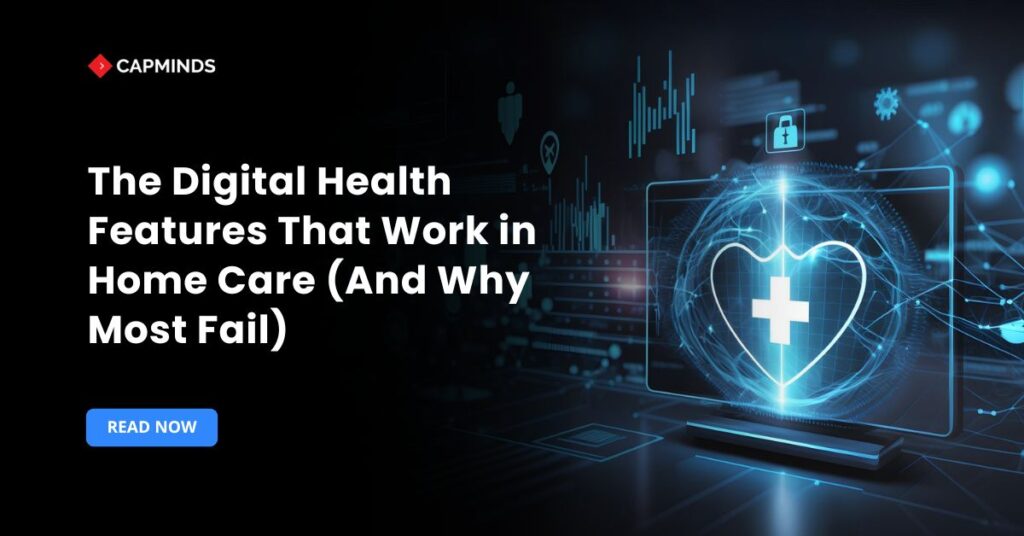The Digital Health Features That Work in Home Care (And Why Most Fail)
Most hospitals used to get frustrated because they spent millions on digital health tech solutions. However, the results were still not as expected. One such hospital has spent over $2.3 million on digital health tech for the past two years, but its readmission rates are still climbing high.
This scenario plays out in boardrooms across America every single day. Healthcare executives are drowning in vendor promises while their patients suffer from fragmented care and their staff burn out from clunky systems that create more work than they eliminate.
But here’s what’s interesting: while 73% of digital health implementations fail to meet their promised ROI within the first year, the remaining 27% are seeing transformational results. What’s the difference? They’ve focused on specific features that move the needle.
Why Most Digital Health Investments Disappoint
Healthcare IT is littered with expensive platforms that never gained traction. We’ve worked with dozens of health systems over the past decade, and the pattern is always the same:
- Organizations are fooled by flashy demos and comprehensive feature lists, then struggle with poor adoption and minimal impact.
- The problem isn’t the technology itself. It’s that most healthcare leaders are asking the wrong questions.
- Instead of “What can this platform do?” they should be asking, “Which specific features will solve our biggest operational headaches and improve patient outcomes?”
The home care space is particularly challenging because you’re dealing with multiple stakeholders:
- Patients who may not be tech-savvy
- Family caregivers who are overwhelmed
- Clinical staff who are already stretched thin.
Any technology that adds complexity instead of reducing it is doomed from the start.
What Drives Results: The Five Features That Matter
After analyzing implementation data from 200+ healthcare organizations, five features consistently separate the winners from the failures. These aren’t the best capabilities, but they’re the ones that generate measurable ROI.
1. Real-Time Monitoring
Here’s what most people get wrong about remote patient monitoring:
- Collecting data isn’t the same as preventing problems.
- We’ve seen organizations spend hundreds of thousands on RPM systems that generate beautiful dashboards but don’t change clinical outcomes.
The game-changing feature is predictive alerting based on trend analysis, not just threshold violations. For example, the Cleveland Clinic’s home heart failure program saw readmissions drop by 44% when it implemented algorithms that track subtle changes in daily weight patterns combined with activity levels.
The system flags patients for intervention 5-7 days before traditional “weight gain” alerts would trigger.
St. Mary’s Health System in Nevada reduced its post-surgical infection rates by 31% using similar predictive approaches.
Their system analyzes temperature trends, medication adherence, and patient-reported symptoms to identify infections before they become serious enough to require hospitalization.
The financial impact is substantial. Organizations with predictive RPM save an average of $1,847 per patient per month compared to reactive monitoring systems. More importantly, patient satisfaction scores improve because they feel supported rather than just watched.
Related: How Does a Remote Patient Monitoring System Reduce ED Visits?
2. AI That Reduces Workload
Most healthcare AI generates alert fatigue rather than actionable insights. I recently worked with a home care agency that was getting 340 AI-generated alerts per day. Their nurses were spending more time managing false alarms than caring for patients.
The breakthrough comes from AI that learns your organization’s specific patterns and reduces noise over time. Successful implementations use machine learning to understand which combinations of factors predict problems in your patient population.
Take Mercy Health’s approach: their AI system initially generated 280 alerts per day across 1,200 home care patients. After six months of learning, it was down to 31 alerts per day, but 89% of those alerts resulted in meaningful interventions. The false positive rate dropped from 67% to 11%.
The key is implementation methodology. Organizations that succeed start with small pilot groups, allow the AI to learn for at least 90 days before making major workflow changes, and involve frontline staff in refining the algorithms. Those who rush deployment see poor results and user resistance.
3. Health IT Systems Integration
How many times have you heard “our system integrates with everything,” only to discover that “integration” means exporting CSV files and manual data entry. Real integration means bidirectional data flow that happens automatically without staff intervention.
The most successful organizations prioritize three specific integration points:
- EHR synchronization, medication management systems
- Family communication platforms.
When these work seamlessly, the impact is dramatic. Genesis Healthcare implemented a platform that automatically updates patient records in their EHR based on home monitoring data.
This eliminated 2.3 hours of documentation per patient per week for their nursing staff. More importantly, it reduced medication errors by 28% because physicians had access to real-time information when making prescribing decisions.
The technical requirement that matters most is API-first architecture with real-time synchronization. Batch updates and nightly data transfers don’t cut it in today’s healthcare environment, where patient conditions can change rapidly.
Related: EHR in 90 Days: Accelerating Digital Transformation in Healthcare
4. Mobile Design That Patients Use
User adoption is the biggest predictor of digital health success, and mobile experience is the biggest predictor of user adoption. But most healthcare apps are designed by engineers who’ve never tried to help an 82-year-old patient with arthritis navigate a smartphone.
The organizations seeing the best results focus obsessively on simplicity. I’m talking about apps with three buttons maximum on the home screen, text large enough to read without glasses, and voice input options for everything.
Kaiser Permanente’s home care app achieves 87% patient engagement because it eliminated every non-essential feature. Patients can report symptoms, message their care team, and access medication reminders. Compare that to comprehensive platforms with 15+ features that see 34% engagement rates.
The same principle applies to provider-facing mobile tools. Successful implementations give field staff exactly what they need for patient visits: basic documentation, medication verification, and emergency contact information. Feature bloat kills adoption.
5. Security Features
Healthcare security is often treated as a necessary evil that slows everything down. But the best digital health platforms use security as a competitive advantage by building trust with patients and providers.
The difference is transparency.
- Patients want to know how their data is protected, but they don’t want to jump through hoops every time they use the system.
- The most successful platforms explain their security measures in plain English and use biometric authentication that’s faster than passwords.
Intermountain Healthcare’s patient portal achieved 91% adoption partly because it invested in explaining its security approach. Patients understood that their data was protected without feeling like they were entering Fort Knox every time they logged in.
For providers, the key is role-based access that matches clinical workflows. Instead of complex permission systems, successful platforms use contextual access that gives users exactly the information they need for their current task.
The Implementation Strategy
Technical features matter, but implementation strategy determines success or failure. The organizations that achieve their ROI goals follow a surprisingly consistent playbook.
- They start with a specific use case that solves a clear problem.
- Not “improving patient outcomes” but “reducing heart failure readmissions for patients discharged from the cardiac unit.”
- This focused approach allows them to measure results and refine their approach before expanding.
They involve frontline staff in platform selection and customization. The biggest implementation failures happen when IT departments choose systems without input from the people who will use them daily.
Successful organizations form multidisciplinary teams that include nurses, physicians, and even patients in the decision-making process. They plan for 6-12 months of optimization after go-live.
Digital health platforms aren’t like traditional software that works the same way forever. They need continuous adjustment based on user feedback and outcome data.
The ROI Reality Check
Let’s talk numbers. The most successful digital health implementations in home care generate ROI through five specific mechanisms:
- Reduced acute care utilization accounts for 40-60% of cost savings.
- When patients can manage their conditions at home with proper support, emergency department visits and hospitalizations drop significantly.
Improved staff efficiency typically saves 15-25% of operational costs. When nurses spend less time on documentation and travel, they can serve more patients or provide higher-quality care.
Better medication adherence reduces adverse events by 20-30%. Digital health platforms that include medication management see fewer complications and better patient outcomes. Enhanced family engagement reduces caregiver burnout and improves patient satisfaction.
When families feel supported and informed, patients are more likely to follow care plans and less likely to experience crises. Regulatory compliance becomes easier and less expensive.
Platforms that automatically generate required documentation and track quality metrics reduce administrative burden and audit risk.
Making the Right Choice for Your Organization
The digital health market is crowded with vendors making similar promises. How do you separate platforms that deliver results from those that disappoint?
Start with references from organizations similar to yours. Don’t just ask for customer lists, request specific outcome data and implementation timelines. The best vendors will share detailed case studies that include both successes and challenges.
Evaluate the vendor’s implementation methodology, not just their technology.
Companies that provide dedicated implementation teams, comprehensive training programs, and ongoing optimization support are more likely to help you achieve your goals.
Consider the total cost of ownership, including training, customization, and ongoing support. The cheapest platform upfront often becomes the most expensive over time if it requires extensive customization or generates poor user adoption.
Transform Your Home Care with CapMinds’ Digital Health Solutions
Choosing the right technology partner can make all the difference in patient outcomes and operational efficiency. At CapMinds, we specialize in building robust digital health solutions that drive real results.
Our expertise lies in delivering custom solutions tailored to the unique needs of home care, ensuring seamless integration and user adoption.
We offer a comprehensive range of services to enhance your home care programs:
- Custom EHR/EMR Development: Tailored to meet the specific needs of home care organizations.
- EHR Integration & Migration: Smooth data integration that connects disparate systems to provide a unified view of patient information.
- AI Implementation: Use AI to predict patient outcomes, reduce workloads, and improve decision-making.
- Real-Time Monitoring Programs: Predictive RPM systems that lower readmission rates and improve patient outcomes.
- Ongoing Support and Optimization: Ensuring continuous improvement with real-time support and system updates.
Partner with CapMinds to implement scalable, effective, and intuitive digital health solutions that will streamline your home care processes, improve patient outcomes, and reduce costs.




